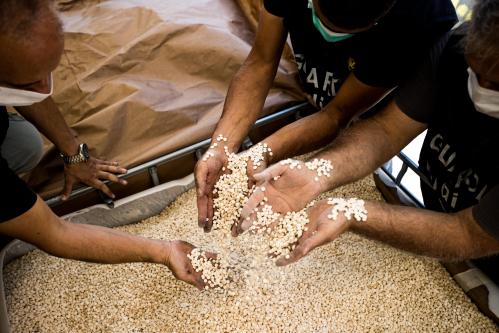Al Qaeda is on the defensive in Pakistan, but its many allies and affiliates are on the march. Four years after al Qaeda murdered Benazir Bhutto, her warnings about the jihadist syndicate in Pakistan have been born out; it is the most dangerous terror threat in the world today.
Saeed, who now heads Lashkar’s official successor Jamat ud Dawa, called for jihad against India in Kashmir and NATO in Afghanistan. He said Israel has tried to steal Pakistan’s nuclear weapons in the past and failed, and now America was trying to seize the country’s nuclear arsenal and must be defeated. He called on Pakistanis to back the army in fighting America and for the overthrow of the civilian government of President Ali Asif Zardari, and he rejected Zardari’s proposal for most-favored trade agreement with India. Instead, India must be punished for stealing Kashmir in 1947 and for helping Bangladesh secede from Pakistan in 1971. Jihad is the only answer to America, Israel and India.
Along with the black and white flags of Lashkar-e-Taiba, the crowd was also full of the flags of a half dozen other terror groups like Sipha i Sahaba, which specializes in killing Shia, and the Afghan Taliban, our enemy in Afghanistan for the last decade. Other speakers included the son of Pakistan’s third military dictator, Ijaz ul Haq, who has long backed jihadist causes and is a supporter of Pakistan’s nuclear proliferator A.Q. Khan, and Hamid Gul, a former director general of the ISI known to be very close to the Afghan Taliban leadership in Quetta, Pakistan. The common feature of all the groups and individuals at the Minar-e Pakistan is their long connections to the ISI.
In 2008, Barack Obama promised to make the al Qaeda core, or al Qaeda al Umm (mother al Qaeda), his top target if elected. Three years later, the group is on the defensive, its leader Osama bin Laden found in Abbottabad, Pakistan and killed, his lieutenants hunted by drones and his successor Ayman Zawahiri under siege. Al Qaeda al Umm has never faced the pressure it is facing today.
The group’s allies and affiliates in Pakistan, by contrast, are under virtually no pressure. Indeed, they enjoy the support of Pakistan’s army and the patronage of its spy service, the Inter Services Intelligence Directorate, or ISI. They are flourishing. This month, they held an open-air rally in Lahore, Pakistan’s second-largest city, at the spot where Pakistan’s founders first called for its creation in 1940: the Minar-e Pakistan. The founder of Lashkar-e-Taiba, the group that attacked Mumbai in 2008, Hafiz Saeed, was the host and master of ceremonies. According to the police, at least 70,000 people joined the rally, which was called in the “defense of Pakistan” after two dozen Pakistani soldiers died in NATO airstrikes last month.
It was a remarkable declaration of strength and power. The jihadist groups promised further mass demonstrations in 2012 in Rawalpindi, the country’s military capital, and Karachi, its largest city and port. Saeed, who openly mourned bin Laden’s death last May as the hero of modern jihad, graphically demonstrated the power of the jihadist syndicate in the world’s second largest Muslim country with the fastest-growing nuclear arsenal.
Four years ago, on December 27, 2007, this syndicate murdered former Prime Minister Bhutto. The UN investigation of the assassination concluded the plot was lead by al Qaeda—probably by its master terrorist Ilyas Kashmiri, who was trained for years by the ISI—and conducted with the help of other parts of the syndicate. It also concluded the ISI had deliberately destroyed the forensic evidence at the crime scene, probably to cover up its own hand in the killing.
Ms. Bhutto had warned before her death that the alliance of jihadist terror and the army was the greatest threat to world peace today, a terror threat much more dangerous in the long term than bin Laden’s gang could ever be because it had control of the instruments of a state within a state. She predicted this syndicate of terror would be marching on Pakistan’s major cities within four years. She was all too right.
Three years ago in Mumbai, the syndicate demonstrated its terror capabilities. It held the financial capital of India in its deadly grip for days, killing and wounding hundreds including Indians, Americans and Jews. The court testimony of an American, David Headley, who was the master spy for the attack and prepared the way with five visits to the city before hand, shows it was a joint Lashkar-ISI plot. That attack was the first major international crisis after Obama’s electoral victory.
The president has delivered on his promises to “disrupt, dismantle and defeat” al Qaeda al Umm. He showed great courage and leadership in sending the SEALs to Abbottabad this year. In 2012 he will need to reset American policy toward Pakistan to contain the worst excesses and ambitions of the Pakistani army, the ISI and the syndicate of terror they sponsor while at the same time engaging and supporting those Pakistanis who want a democratic, progressive Pakistan like Benazir. That is a tough balance to get right. It may be the toughest challenge of his presidency.



Commentary
Op-edPakistan’s Jihadist Threat: Obama’s Terrorism Challenge in 2012
December 21, 2011